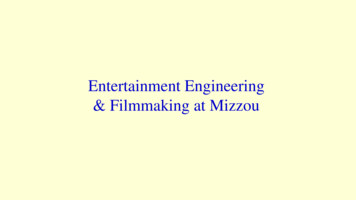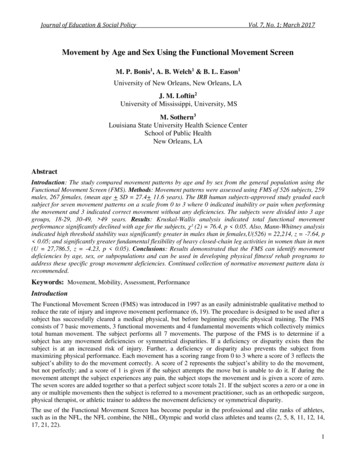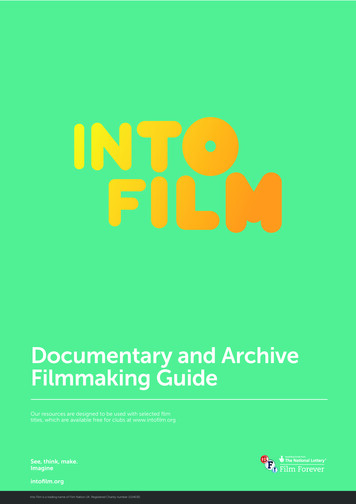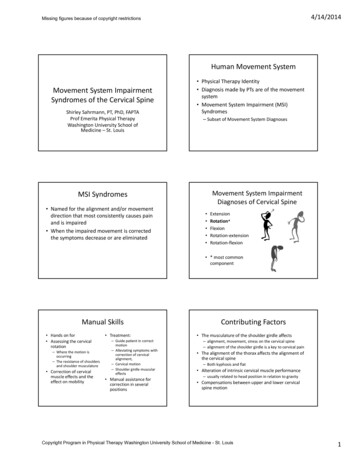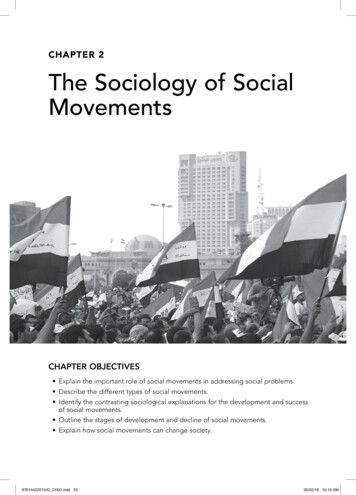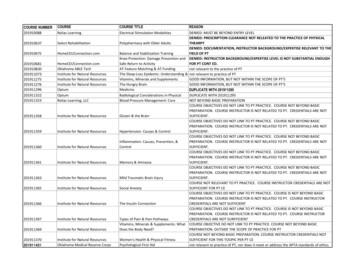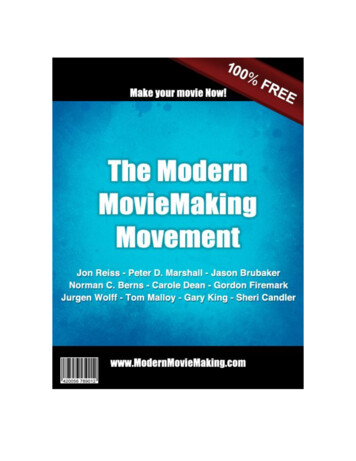
Transcription
The Modern MovieMaking Movement1No part of this eBook may be copied or sold. however YOU are encouraged to GIVE thiseBook (in its entirety) to everyFilmmaker you knowFor FREE! 2011 Brubaker Unlimited LLCAll rights reserved worldwide.Brubaker Unlimited LLC6767 Sunset Blvd. #153Los Angeles, CA w.comAREProductions of Brubaker Unlimited LLCThanks to Ian Hannin for design com
The Modern MovieMaking Movement2Before we get to the filmmaking stuff, here is some legal stuff EARNINGS AND INCOME DISCLAIMERNo Earnings Projections, Promises or Representations - For purposes of thisdisclaimer, the term “Author” refers individually and collectively to the author ofthis eBook and to the affiliate (if any) whose affiliate links are embedded in thiseBook. You recognize and agree that the Author has made no implications,warranties, promises, suggestions, projections, representations or guaranteeswhatsoever to you about future prospects or earnings, or that you will earn anymoney, with respect to your purchase of this eBook, and that the Author has notauthorized any such projection, promise, or representation by others. Any earningsor income statements, or any earnings or income examples, are only estimates ofwhat you might earn. There is no assurance you will do as well as stated in anyexamples. If you rely upon any figures provided, you must accept the entire risk ofnot doing as well as the information provided. This applies whether the earnings orincome examples are monetary in nature or pertain to advertising credits which maybe earned (whether such credits are convertible to cash or not). There is noassurance that any prior successes or past results as to earnings or income (whethermonetary or advertising credits, whether convertible to cash or not) will apply, norcan any prior successes be used, as an indication of your future success or resultsfrom any of the information, content, or strategies. Any and all claims orrepresentations as to income or earnings (whether monetary or advertising credits,whether convertible to cash or not) are not to be considered as "average earnings".Testimonials & ExamplesTestimonials and examples in this eBook are exceptional results, do not reflect thetypical purchaser's experience, do not apply to the average person and are notintended to represent or guarantee that anyone will achieve the same or similarresults. Where specific income or earnings (whether monetary or advertising credits,whether convertible to cash or not), figures are used and attributed to a specificindividual or business, that individual or business has earned that amount. There is noassurance that you will do as well using the same information or strategies. If yourely on the specific income or earnings figures used, you must accept all the risk ofnot doing as well. The described experiences are atypical. Your financial results arelikely to differ from those described in testimonials.COPYRIGHT AND TRADEMARK NOTICESThis eBook is Copyright 2011 Brubaker Unlimited LLC (the “Author”). All RightsReserved. Published in the United States of America. The legal notices, disclosures,and disclaimers at the front of this eBook are Copyright 2009 Law Office ofMichael E. Young PLLC, and licensed for use by the Author. All rights reserved. Youare permitted to reproduce this eBook in entirety and distribute to every filmmakeryou know. For information, please contact the Author at Jason@FilmmakingStuff.comor by mail at Brubaker Unlimited LLC; 6767 Sunset Blvd #153 Los Angeles, CA 90028.All trademarks and service marks are the properties of their respective owners. Allreferences to these properties are made solely for editorial purposes. Except formarks actually owned by the Author, the Author (as both author and as publisher)does not make any commercial claims to their use, and is not affiliated with them inany way. Unless otherwise expressly noted, none of the individuals or businessentities mentioned herein have endorsed the contents of this eBook.www.ModernMovieMaking.com
The Modern MovieMaking Movement3LIMITS OF LIABILITY & DISCLAIMERS OF WARRANTIESThe materials in this eBook are provided "as is" and without warranties of any kindeither express or implied. The Author disclaims all warranties, express or implied,including, but not limited to, implied warranties of merchantability and fitness for aparticular purpose. The Author does not warrant that defects will be corrected, orthat that the site or the server that makes this eBook available are free of viruses orother harmful components. The Author does not warrant or make anyrepresentations regarding the use or the results of the use of the materials in thiseBook in terms of their correctness, accuracy, reliability, or otherwise. Applicablelaw may not allow the exclusion of implied warranties, so the above exclusion maynot apply to you.Under no circumstances, including, but not limited to, negligence, shall the Authorbe liable for any special or consequential damages that result from the use of, or theinability to use this eBook, even if the Author or his authorized representative hasbeen advised of the possibility of such damages. Applicable law may not allow thelimitation or exclusion of liability or incidental or consequential damages, so theabove limitation or exclusion may not apply to you.In no event shall the Author's total liability to you for all damages, losses, and causesof action (whether in contract, tort, including but not limited to, negligence orotherwise) exceed the amount paid by you, if any, for this eBook. Facts andinformation are believed to be accurate at the time they were placed in this eBook.All data provided in this eBook is to be used for information purposes only. Theinformation contained within is not intended to provide specific legal, financial or taxadvice, or any other advice whatsoever, for any individual or company and should notbe relied upon in that regard. The services described are only offered in jurisdictionswhere they may be legally offered. Information provided is not all-inclusive, and islimited to information that is made available and such information should not berelied upon as all-inclusive or accurate. For more information about this policy,please contact the Author at the e-mail address listed in the Copyright Notice for thiseBook.AFFILIATE COMPENSATION DISCLOSUREThis eBook contains hyperlinks to websites and information created and maintainedby other individuals and organizations. The Author does not control or guarantee theaccuracy, completeness, relevance, or timeliness of any information or privacypolicies posted on these linked websites. You should assume that all references toproducts and services in this eBook are made because material connections existbetween the Author and the providers of the mentioned products and services(“Provider”). You should also assume that all hyperlinks within this book areaffiliate links for either (a) the Author or (b) someone else who is an affiliate for thementioned products and services (individually and collectively, the “Affiliate”).The Affiliate recommends products and services in this eBook based in part on a goodfaith belief that the purchase of such products or services will help readers ingeneral. The Affiliate has this good faith belief because (a) the Affiliate has tried theproduct or service mentioned prior to recommending it or (b) the Affiliate hasresearched the reputation of the Provider and has made the decision to recommendthe Provider‟s products or services based on the Provider‟s history of providing theseor other products or services.www.ModernMovieMaking.com
The Modern MovieMaking Movement4The representations made by the Affiliate about products and services reflect theAffiliate„s honest opinion based upon the facts known to the Affiliate at the time thiseBook was distributed by the Affiliate. Because there is a material connectionbetween the Affiliate and Providers of products or services mentioned in this eBook,you should always assume that the Affiliate may be biased because of the Affiliate‟srelationship with a Provider and/or because the Affiliate has received or will receivesomething of value from a Provider. Perform your own due diligence beforepurchasing a product or service mentioned in this eBook. The type of compensationreceived by the Affiliate may vary. In some instances, the Affiliate may receivecomplimentary products, services, or money from a Provider prior to mentioning theProvider‟s products or services in this eBook. In addition, the Affiliate may receive amonetary commission or non-monetary compensation when you take action byclicking on a hyperlink in this eBook. This includes, but is not limited to, when youpurchase a product or service from a Provider after clicking on an affiliate link in thiseBook.The EconomyThe economy, both where you do business, and on a national and even worldwidescale, creates additional uncertainty and economic risk. An economic recession ordepression might negatively affect your results.Your Success or Lack of ItYour success in using the information or strategies provided in this eBook depends ona variety of factors. The Author has no way of knowing how well you will do, as hedoes not know you, your background, your work ethic, your dedication, yourmotivation, your desire, or your business skills or practices. Therefore, he does notguarantee or imply that you will get rich, that you will do as well, or that you willhave any earnings (whether monetary or advertising credits, whether convertible tocash or not), at all. Businesses and earnings derived therefrom involve unknown risksand are not suitable for everyone.You may not rely on any information presented in this eBook or otherwise providedby the Author, unless you do so with the knowledge and understanding that you canexperience significant losses (including, but not limited to, the loss of any moniespaid to purchase this eBook and/or any monies spent setting up, operating, and/ormarketing your business activities, and further, that you may have no earnings at all(whether monetary or advertising credits, whether convertible to cash or not).Forward-Looking StatementsMaterials in this eBook may contain information that includes or is based uponforward-looking statements within the meaning of the securities litigation reform actof 1995. Forward-looking statements give the Author's expectations or forecasts offuture events. You can identify these statements by the fact that they do not relatestrictly to historical or current facts. They use words such as “anticipate,”“estimate,” “expect,” “project,” “intend,” “plan,” “believe,” and other words andterms of similar meaning in connection with a description of potential earnings orfinancial performance.www.ModernMovieMaking.com
The Modern MovieMaking Movement5Any and all forward looking statements here or on any materials in this eBook areintended to express an opinion of earnings potential. Many factors will be importantin determining your actual results and no guarantees are made that you will achieveresults similar to the Author or anybody else, in fact no guarantees are made thatyou will achieve any results from the Author's ideas and techniques found in thiseBook.Due DiligenceYou are advised to do your own due diligence when it comes to making businessdecisions and should use caution and seek the advice of qualified professionals. Youshould check with your accountant, lawyer, or professional advisor, before acting onthis or any information. You may not consider any examples, documents, or othercontent in this eBook or otherwise provided by the Author to be the equivalent ofprofessional advice. The Author assumes no responsibility for any losses or damagesresulting from your use of any link, information, or opportunity contained in thiseBook or within any other information disclosed by the Author in any formwhatsoever.YOU SHOULD ALWAYS CONDUCT YOUR OWN INVESTIGATION (PERFORM DUEDILIGENCE) BEFORE BUYING PRODUCTS OR SERVICES FROM ANYONE VIA THEINTERNET. THIS INCLUDES PRODUCTS AND SERVICES SOLD VIA HYPERLINKSEMBEDDED IN THIS EBOOKwww.ModernMovieMaking.com
The Modern MovieMaking Movement6Table of ContentsTable of Contents . 6Introduction . 7Successful Screenwriting . 9Making the Most of Movie Money .19Six Ways to Finance a Feature Film .27Fundraising and Crowdfunding for Success .49The Role of the First AD During Pre-Production .62Modern Guerrilla Filmmaking .76The Producer of Marketing and Distribution .85Film Festivals: Why Should I Bother?.95Sell Your Movie Without the Middle-Man . 107Resources . 117www.ModernMovieMaking.com
The Modern MovieMaking Movement7IntroductionBy Tom Malloywww.BankrollTheBook.comThe state of the union of independent film is constantly in flux.What was true a mere three years ago may not be true today.Only a select, small group of people continue to monitor thesetrends, and continue to adjust their business modelsaccordingly. These people are the successful people in the IndieFilm World. I once asked a master salesman, who possessed oneof the biggest books of business in the United States, what hissecret was. His response: “I constantly change and adapt.”You are reading this book to give you a leg up on film financing,production and distribution. All the experts in the followingpages have fought in the trenches and have achieved success inIndependent film by adapting their approaches to the currentmarket time and again.Everything changed in September 2008, when the United Stateswent through its horrible banking crisis. The bottom line was,people couldn’t get loans. Many films set to be financed,especially those to be financed by private equity, could not besupported, because no one had banks where they could takeout huge lines of credit.I had a discussion at Cannes this year with a notable producerfriend, and we both jokingly noted that there are two types ofprofitable films: 1) Films with budgets over 80 million, and 2)Films with budgets under 1 million. I am not sure that was ajoke. In fact, I’m starting to believe it is 100% accurate.I’ll argue with anyone that the films in the 3-8 million range,while some are still being made, are next to impossible tomonetize. It used to be simple The profits would come in as awww.ModernMovieMaking.com
The Modern MovieMaking Movement8result of foreign sales and DVDs. But foreign sales have nowfallen off a cliff, and do you know of anyone who buys DVDsanymore? In five years, pretty much everyone will have thepower to download any film through a set top box directly totheir TV. DVDs are yesterday’s news.So is this all gloom and doom? Not at all, if you’re looking at itwith the right perspective. Your focus should be on makingmovies, not making money. The old days where someone coulddo one film and make a huge profit are gone. It’s the neweconomy, outlined in the NY Times Bestseller The Long Tail.One’s mindset should be how to make less from more instead ofmore from less. This means you must accept fewer profits, butaccept them on more movies, to ultimately be successful.I sign all of my emails, “Make Movies!” I encourage you tochange your mindset to the long run. Be in the game for life.Don’t be in the game playing a big lottery ticket and walk away.If that’s your play, understand that a lottery ticket is what it is It is an extreme long shot.Opportunities exist today that never existed years ago. You cannow buy a movie camera for under 5k that is theatrical quality!You can hire actors and crew for a fraction of what it used tocost! Why? Because the amount of work out there is less, andthe money behind that work is significantly less.For evidence of this, note how many former film stars are doingtelevision right now? This is happening because TV still hasmoney. Films, at least on the independent level, do not.Ask yourself why you want to be in the movie business. If it is tomake a boatload of money, that, while possible, is the wrongreason. If it’s to make great art, mingle with celebrities, attendthe greatest parties, meet fantastic people, deal with sharks butlearn from it all, make something you’re proud of, enjoy notwww.ModernMovieMaking.com
The Modern MovieMaking Movement9being behind a desk, experience the crack high of being on set,walk red carpets, or any of the above I can tell you frompersonal experience, it’s 100% possible.Read this book, apply the techniques, and do it. See you on set!Tom Malloy is an Actor, Writer and Producer, specializing inindependent films. He is the author of BANKROLL: A NewApproach to Financing Feature Films, which is the best reviewedbook on film financing, and is considered a “gold standard” inindie films circles. To date, Tom has raised over 15 million inprivate equity from independent financiers.To find out more about Tom, goto: www.trickcandle.comwww.tommalloy.com and don’t forget to grab a copy ofBANKROLL at www.BankrollTheBook.comwww.ModernMovieMaking.com
The Modern MovieMaking Movement10Successful ScreenwritingBy Jurgen Wolffwww.ScreenWritingSuccess.comFilmmakers are excited about making films. This sometimesleads them into the number one problem of indie films: weakscripts. It’s tempting to assume that your skill as a director,editor, and perhaps actor will cover for that. Unfortunately if thescript is flawed the final product will be as well.Of course it’s impossible to cover every aspect of scriptwriting inone chapter, but let’s look at the four faults that hamper manyscripts and how to overcome them. These issues are weakcharacters, bad dialogue, plots that sag in the middle, andstupid endings.Getting to know themIf the characters in your script come across as shallow it’sprobably because you don’t know them well enough. Too manyindependent films (and, to be frank, Hollywood films as well)suffer from characters that come across as stereotypes, doingwhat they do only because the plot requires them to, ratherthan from any plausible motivation.What’s the best way to get to know your characters? Thetraditional approach has been to write a biography thataddresses their mental, physical and social dimensions. Theproblem is that deciding where the character went to school,how tall she is, whether he’s an only child, etc. feels kind ofarbitrary. You can do it and still not feel any connection to yourcharacter.www.ModernMovieMaking.com
The Modern MovieMaking Movement11I prefer an approach that allows you to discover charactersrather than inventing them. What you do is imagine thecharacter in a variety of situations. For example, let’s say yourprotagonist is a university professor. Now daydream what hewould do if, for instance, he saw a teen-ager shoplifting at hislocal supermarket. Would he report it? Would he try to talk theyoungster into putting the item back? Would he look the otherway? The great thing is that your intuition will guide yourimagination.If you find it hard to do this just in your imagination, you canemploy a method that Alvin Sargent (“Julia,” “Ordinary People,”“Spiderman”) told me he uses. He imagines the characters invarious situations and writes scenes about what happens. Someof the scenes are ones that he thinks will be in the movie,others are just explorations.When you’ve done this for individual characters, you can moveon to imagining two of more of your characters in the samesituation. Again, these don’t have to be situations that willactually appear in your script, their main purpose is to let youget to know the characters and their values and behaviour.What do they want?It has become a cliché of screenwriting that your charactershave to want something strongly in order to be of interest toyour audience, and I think that’s true. Imagine you’re on thestreet and you see two people. One is sitting on a bench,waiting for a bus. The other is climbing up a drainpipe toward awindow. Which one do you find more interesting?That doesn’t mean that every character has to be the heroictype who will mow down all opposition. Some characters justwant to be left alone (in which case your job is to make surethat they won’t be). If the man on the bus bench steadfastlywww.ModernMovieMaking.com
The Modern MovieMaking Movement12refuses to talk to a friendly lady who keeps trying to makeconversation with him, which makes him interesting, too.There are two wants to consider: what the character wants ingeneral, and what they want within each scene. If you don’tknow that for each of your major characters, it’s time to go backto daydreaming and figuring it out. It’s not necessarily the casethat they have this want at the start of the story, or that their“want” stays the same.Another question that’s useful is what does your characterneed? That may be different from what they want. Often a plotis the story of how a character goes after what he wants and inthe process discovers he needs something totally different andgoes after that and changes in the process. That’s what’sreferred to as the character arc.In Hollywood pictures the protagonist usually reaches his goal.In independent pictures, which tend to be more like reality,sometimes he does, sometimes he doesn’t. A good example is“The Wrestler,” in which the protagonist realizes tries to changebut can’t.When you know your characters well, the final important step isto make sure they behave in a way that’s congruent with whothey are. Sure, a mild-mannered accountant can pick up a gunand go after the people who bullied his brother to the point ofsuicide—but only if you’ve laid the groundwork for it. It doesn’thave to be predictable but it does have to be plausible.This is especially important if your story has a villain of somekind, even just an unpleasant person. Nobody wakes up in themorning thinking, “Oh boy, another day in which I can be ajerk.” Jerks don’t know they’re jerks and when we understandwhat motivates them they stop being stereotypes.www.ModernMovieMaking.com
The Modern MovieMaking Movement13Making them talkWhen you get to know your characters you should reach thepoint where you can hear them talking in your head. How theyspeak and what they say will reflect their backgrounds,education, and the people they hang around with.If your characters sound too similar, a simple technique toovercome this is to coming up with a metaphor for eachcharacter, or a figure from history or films or novels.In writing “The Social Network” I’m sure Aaron Sorkin didn’t usethis method to differentiate between the Mark Zuckerbergcharacter (played by Jesse Eisenberg) and the Eduardo Saverincharacter (played by Andrew Garfield), but if he was a fan of“Star Trek” he could have used Spock as a model for Zuckerbergand Bones for Saverin.Sometimes one character might be like a cat and another like adog, or one might be like Scarlett O’Hara and another likeScrooge (pre-conversion).As soon as you get this kind of feel for a character, you’ll find iteasier to write dialogue (and actions) that set them apart fromeach other.Step away from the expositionThe most common clunky dialogue is exposition: giving theaudience facts they need to know via words real people wouldnever say. Like, “Joe, in the twelve years we’ve known eachother I’ve never asked you for a favor, but-- ”OK, I get it, we’re supposed to know they go back a long way.But there are more elegant ways of letting us know that. If indoubt, a little humor helps (assuming that’s in line with thewww.ModernMovieMaking.com
The Modern MovieMaking Movement14general tone of your script, of course). In this case, it might besomething like, “I’ve never asked you for a favor, but—“Yes youhave. I helped you move.” “That was ten years ago.” “So? It stillcounts.”Sometimes you can introduce a character who logically can askquestions you need to have answered—a reporter, a newneighbor, a hairdresser.Finally, if you need to have somebody give a slab of information,at least have them doing something interesting while they talk.The second act swampWhen I worked as a script reader I came across a lot of scriptsthat captured my attention with a great premise that wasestablished in the first act (the first 20 to 30 pages). However,the number that delivered on that promise was tiny.The problem often is that you know your opening and you knowyour ending but you don’t have enough material to sustain themiddle. If that’s your issue, here are three strategies: Revisit the question of what your protagonist and othercharacters want. How has this changed since the beginningof the story? What new problems arise from these changes?Even a small shift can give you an idea for additional scenesand developments. Brainstorm how any minor characters you introduced in thefirst quarter or third of the story might have a biggerpresence in your protagonist's life. Don't be afraid ofcoincidence as long as you follow the old rule: Coincidence isan acceptable way to get your characters into trouble, butnot an acceptable way to get them out of trouble.www.ModernMovieMaking.com
The Modern MovieMaking Movement15Consider whether you need to go back to the first part of thestory to plant something that can pay off in the middle.Escalate!In the second act things have to keep escalating. Each newdevelopment should put your protagonist in greater dangerwhether that’s physical or emotional or a combination of thetwo, although you should also have a few lulls in between togive your audience time to breathe and to increase the impactwhen they and your protagonist realize there’s more trouble onthe way.Check whether the challenges you present in Act Two areinterchangeable. In other words, would the third problem yourprotagonist encounters work just as well if it came first? Is thethird problem at the same level of intensity as the second? If so,you haven’t escalated. Ideally each new challenge grows out ofand is more intense than the previous one.Let’s look at the example of a romantic comedy. On the firstdate, the guy tries to impress the girl by mentioning that he hasa fancy boat. She says she’d love to go on it so he invites her forthe following weekend. He doesn’t actually have a boat but hisbest friend’s parents do and he borrows it for the second date.Because he doesn’t know how to operate the boat very well, hislie is nearly exposed, but he manages to cover. Unfortunately,the friend didn’t tell his parents about all this and they reportthe boat as stolen. The harbor police stop the boat and arrestour hero and the girl. So far we have these escalations: He lies to the girl and has the problem of making good onthe lie. He manages to get the boat but his lie is nearly exposedbecause he doesn’t know how to operate it.www.ModernMovieMaking.com
The Modern MovieMaking Movement His lie is exposed when the harbor police stop the boat. His lie gets him and the girl arrested.16Notice how each of these developments is closely linked to theprevious ones. Maybe another step would be that when newsof the girl’s arrest comes out she loses her job, so now our herohas not only embarrassed her but ruined her career prospectsas well.If we can keep coming up with bigger and bigger obstacles—aswell as reasons why the girl is willing to even talk to himanymore—then we can move the plot forward. However, it maybe that having the incident above early in the second act makesit too hard to keep escalating, in which case it would makesense to move it closer to the end of the second act.Keep it movingIt’s important to think about not only what you can add but alsowhat you can cut. Screenwriter Jay Presson Allen says thatdirector Alfred Hitchcock taught her more about screenwritingthan she learned in all the rest of her career. She says, “Therewas one scene in Marnie, for example, where this girl is forcedinto marriage with this guy. I only knew how to write absolutelylinear scenes.So I wrote the wedding and the reception and leaving thereception and going to the boat and getting on the boat and theboat leaving. I mean, you know, I kept plodding, plodding,plodding. Hitch said, "Why don't we cut some of that out, Jay?Why don't we shoot the church and hear the bells ring and seethem begin to leave the church. Then why don't we cut to alarge vase of flowers, and there is a note pinned to the flowersthat says, 'Congratulations.'www.ModernMovieMaking.com
The Modern MovieMaking Movement17And the water in the vase is sloshing, sloshing, sloshing."These days the audience is impatient and figuring out that sortof shorthand can not only keep things moving it can also be agreat way to save on the budget (always a consideration in indiefilms).The endYour story doesn’t have to have a happy ending for yourprotagonist, but it should be a happy experience for youraudience, in that it should leave them feeling that the endingmakes sense. Unfortunately, too many films have stupidendings. Here are the main ones to avoid: The convenient coincidence. With no foreshadowing at all, itturns out that one of the villain’s henchmen was working forthe FBI all along, or a neighbor happens to drop by just intime to call the police, or the lights go out just as your guyneeds to get away. As I mentioned above, the rule is that youcan use
The Modern MovieMaking Movement 2 www.ModernMovieMaking.com Before we get to the filmmaking stuff, here is some legal stuff EARNINGS AND INCOME DISCLAIMER No Earnings Projections, Promises or Representations - For purposes of this disclaimer, the term "Author" refers individually and collectively to the author of


